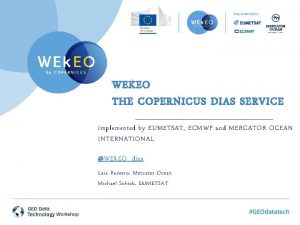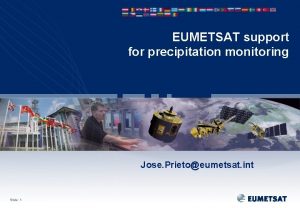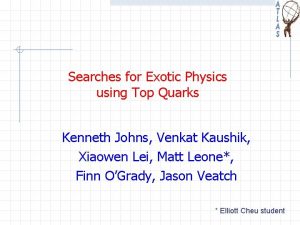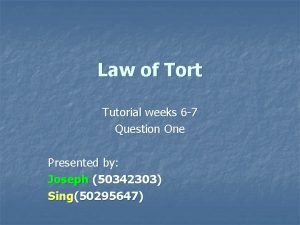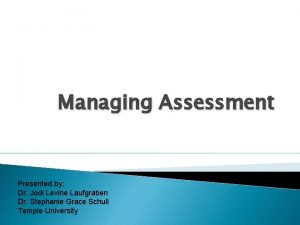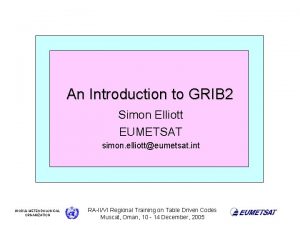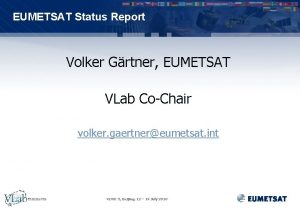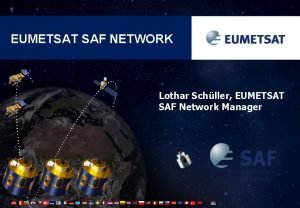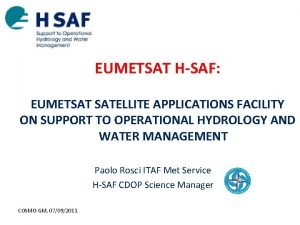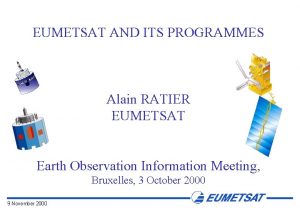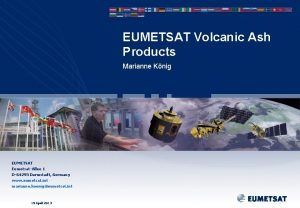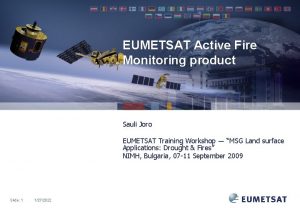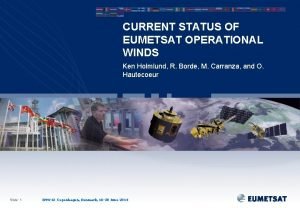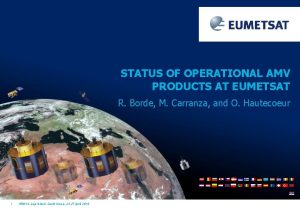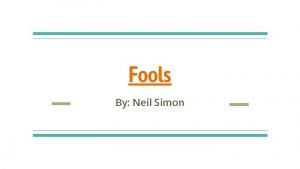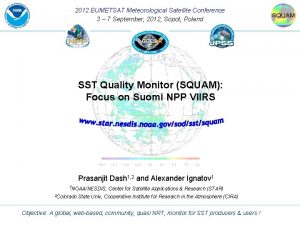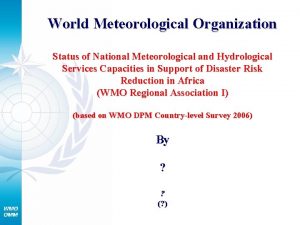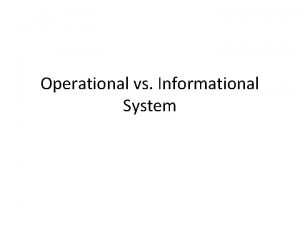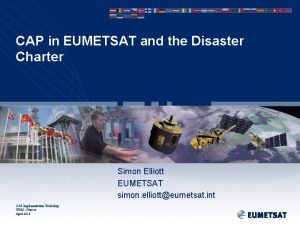EUMETSAT Operational Status 2009 Simon Elliott Meteorological Operations






















- Slides: 22

EUMETSAT Operational Status - 2009 Simon Elliott Meteorological Operations Division simon. elliott@eumetsat. int North America / Europe Data Exchange Meeting ECMWF, Reading, 9 - 11 December 2009

Spacecraft Operations MET-9 at 0° Prime mission. A Safe Mode in August 2009 (after the one in April 2009) due to a Single Event Upset (SEU) on the on board computer. MET-8 at 9. 5°E Backup to Met-9 and RSS. No significant in-orbit anomalies to report. The S/C is beyond its specified lifetime (i. e. 7 years). Successful NS inclination manoeuvre in Oct 09. MET-7 at 57. 5°E IODC service. No new in-orbit anomalies to report. A few tests to define a new S/C configuration are planned to support the IODC DCP mission during eclipse. MET-6 at 67. 5°E IODC DCP and backup to Met-7. No new in-orbit anomalies. A re-orbiting date for Met-6 is under definition (worst case Autumn 2010). Slide: 2

Open Projects RETIM on EUMETCast: Parallel Operations start Feb 2010 after successful final operational validation and acceptance. Earth Observation Portal: Centralised registration by Jan 2010 Reprocessing: Environment available by Nov 2009. Start of MTP reprocessing H 1, 2010. MSG reprocessing after. Adoption of CORE framework for NRT to follow. MSG-3/4: Ground segment upgrade by April 2010, antenna by Dec 2010. Slide: 5

Slide: 7

Metop-A Status • • DHSA: Redundant CCU I/O Board. Further investigation of I/O Board planned following a possible future PLSOL outage. – Incident raised on ULFAR reception of unidentified command packet header HRPT: B unit in restricted operation AMSU A 1: Noise on Channel 7 exceeding specification GOME-2: Throughput testing performed August and September 2009. IASI: patch uploaded to allow autonomous recovery on certain SEUs (September 2009. ) A-DCS: frequency complaints under investigation In-plane manoeuvre planned December 2009. Slide: 8

Metop-A Status Metop-A Major Events Date Event 9 th Aug 09 A-DCS 95 % Loss of Messages SEU Caused all high and low rate messages to be lost. Mission outage 1 day 12: 34: 00 26 th Aug 09 IASI SEU event: - Mission outage due to the SEU event (6 h 6 min) 7 th Sept IASI SEU event: - Mission outage due to the SEU event (17 h 7 min) 17 th Sept Out-of-Plane Manoeuvre: - Mission outages on HIRS, MHS, IASI, SEM, AMSU, GOME 30 th Sept IASI Upload of On-board software for autonomous SEU recovery (for pre-defined anomaly signatures) 29 th Oct IASI SEU event: - Mission outage due to the SEU event (5 h 20 min) Metop-A major events July – 17 November 2009 Slide: 9

Heavy Ion Risk Assessment – Steady State Flux (NOAA) Map of radiation Steady State Flux (NOAA): Blue zone : low risk Red zone : high risk Yellow shape : South Atlantic Anomaly Slide: 10

HRPT: Current and future switch-on scenarios AHRPT reactivation from 29 th Sept 08 Zone extension from May 25 th 09 Slide: 11 Under investigation: Globalisation of AHRPT service… Proton Testing: Refinement of SAA zone operations

Metop-A HRPT Service Way Forward • Metop-A HRPT SSPA transistor proton testing failures indicate that SAA boundaries cannot be crossed. • Expansion of the global coverage will also have a higher level of risk than considered previously taking only heavy ions into account: it is not currently clear how significant a risk this is • If NOAA-17 is no longer capable of providing a morning orbit HRPT service, then there will be a stronger incentive to expand the coverage. • Risk analyses and expansion preparations (including identification of Metop-HRPT ready ground stations) is to be made in readiness for a possible expansion. • Target is HRPT survival until Metop-B finishes commissioning successfully Slide: 12

GOME-2 signal decrease (throughput decrease) SMR signal relative to 1 st of January 2007 745 nm 311 nm 1 st Jan 07 31 st Aug 09 1 st Jan 07 FPA – Main channel detectors PMD-P – Polarisation Measurement Device P PMD-S – Polarisation Measurement Device S Slide: 13 31 st Aug 09

GOME-2 signal before/after throughput test SMR signal relative to 1 st of August – various wavelength main channels FPA 1 265 nm FPA 2 320 nm FPA 3 440 nm FPA 4 640 nm Throughput Test Period Slide: 14

EPS Operations Planning • 2010: – Approach to Metop-A EOL operations to be agreed – Operational debris warning service from NOAA / USAF expected to be activated – Ops Prep for Metop-B to be performed. • 2011: – Antarctic Data Acquisition Demonstration Service (Mc. Murdo) to improve data timeliness (9 out of 14 orbits) – Validation of combined Metop-A/B operations • 2012: – Metop-B launch, commissioning and routine ops start • 2014: – ADA Operational Service Start (all orbits) Slide: 17

EPS Product Operations Status and Planning Product (M 02) Current Status All Level 1 Products Operational ATOVS Level 2 Operational IASI Level 2 (twt, clp) Operational IASI Level 2 (ozo, trg) Demonstration AVHRR L 2 NDVI Operational AVHRR L 2 Polar Winds Demonstration ASCAT Soil Moisture IASI L 1 Compressed Slide: 18 Future Status All Level 1 NOAA-19 products operational. ATOVS L 2 products from NOAA-19 operational Operational 2010 Operational Q 1/2010 Operational Demonstration 2010 EPS Reprocessing will commence 2010

JASON-2 EUMETSAT is part of the 4 -party group operating JASON-2 • Earth terminals in Usingen, Germany and in the USA; • NRT processor provided by CNES and operated by EUMETSAT and NOAA; • OGDR Data are generated in net. CDF and converted to BUFR for dissemination • New NRT processor (v 3) due next month • Addition of significant wave height to disseminated OGDR data after processor upgrade Slide: 19

Third party data services EUMETSAT receives, tailors as necessary and retransmits third party data as requested by users • MODIS level 1 b (MOD 02) retransmitted via EUMETCast after spatial and spectral thinning • MODIS fire data (MOD 14) retransmitted via EUMETCast • Some difficulties with MODIS file names. Navigation data still required. • SSMI and SSMI/S data used at EUMETSAT for precipitation data processing and retransmitted to users via EUMETCast Slide: 20

EARS Objectives The Objectives of the EARS Services are to: • Collect Data from Polar Orbiting Meteorological Satellites via a selected set of HRPT Stations; • Process and Retransmit the Data to End Users via the GTS and the EUMETCast (Ku-Band Europe); • Provide a Timeliness adequate for Local and Regional Numerical Weather Prediction applications (typically < 30 min). • The EARS Operational Service Specification is available under http: //www. eumetsat. int > What We Do > Satellites > EARS System Slide: 21

Reception of Data from Polar Orbiting Satellites Global Data Dump Global Coverage On-Board Data Storage up to 102 / 204 minutes Slide: 22 HRPT (Direct Read-Out) Regional Coverage Immediate Access

The EARS System Polar Satellite Local Product Processing including: HRPT Stations Local Product Processing Slide: 23 EUMETCast Removal of Duplicate HRPT Data Reduction • AVHRR → Cloud Cover • Compression • BUFR EARS • BZIP 2 Communicatio • Principal Component scores n • Data Selection Network • 8461 → 400 IASI Channel GTS • • • Improved Timeliness • Bandwidth Savings Users

EARS Geographical Coverage: Current (24 %) Gilmore Creek ● Edmonton ● Monterey ● Kangerlussuaq ● Gander ● Wallops Svalbard ● Lannion ● Athens ● Maspalomas Slide: 30

EARS Geographical Coverage: Planned (32 %) By Adding: Slide: 31 Moscow ● Muscat ● La Reunion

EARS Geographical Coverage: Potential (45 %) By Adding: Hawaii ● Miami ● Resolute Bay Libreville ● Novosibirsk ● Khabarovsk Slide: 32

Other Evolution Aspects • EARS-IASI service specification under preparation. User community consulted to provide proposals for the selection of the 300 -400 channels to be included in the EARS-IASI products. • Preparations for NOAA-19 Reception and Processing ongoing. • Trial Fengyun-3 Reception and Product Processing planned at Svalbard. Slide: 33
 Wekeo eumetsat
Wekeo eumetsat Eumetsat data center
Eumetsat data center Eumetsat precipitation
Eumetsat precipitation Dr suzanne elliott
Dr suzanne elliott Timo elliott sap
Timo elliott sap Elliott erwitt biography
Elliott erwitt biography Elliott business software
Elliott business software Kathryn elliott
Kathryn elliott Career cruising yrdsb
Career cruising yrdsb Elliott cheu
Elliott cheu Pierre elliott trudeau high school courses
Pierre elliott trudeau high school courses Clark elliott depaul
Clark elliott depaul Career cruising yrdsb
Career cruising yrdsb Sandy elliott
Sandy elliott Elliott richelson
Elliott richelson Pargo v elliott
Pargo v elliott Elliott lancaster
Elliott lancaster Dana elliott
Dana elliott Penfolds wine v elliott
Penfolds wine v elliott Digital solutions bolton
Digital solutions bolton Michael elliott md
Michael elliott md Jodi levine laufgraben
Jodi levine laufgraben Mrs elliott a teacher at durham school of the arts
Mrs elliott a teacher at durham school of the arts
